Bethan Parry
Centre for Ecology and Conservation, University of Exeter, Cornwall Campus, Penryn, Cornwall, TR10 9EZ
Introduction
Globally, the threat of invasive species and their impact on ecosystems is being recognised as an increasing problem. There are various entry routes for invasive species: some may be accidental, some intentional – but there is nearly always an impact from their presence (McNeely, 2001). The rate at which invasive species are occurring has increased in conjunction with the increase in global trade, and in the USA invasive species are considered the second greatest threat to endangered species (Mooney & Cleland, 2001).
Many islands have unique fauna and flora and are particularly vulnerable to disturbance and destruction by human activities. It is recognised that islands have the largest number of invasive species proportionally to their size and that island ecosystems are particularly sensitive to introductions (Mooney & Cleland, 2001). Invasive species by their nature can adapt rapidly to new environments and sometimes actually thrive. There are several possible reasons for this: a higher availability of vacant niches, reduced competition, loss of defensive behaviours in isolated species and small populations being generally less stable (Kairo, 2003). It is also thought that island species would suffer more from hybridisation as they have less genetic diversity than mainland populations (Mooney & Cleland, 2001).
Freshwater turtles and invasive species
There are around 160 freshwater turtle species, many of which are recognised as needing some form of conservation action (Klemens, 2000). The use of turtles for food, oils and shell has been documented from many past civilisations – and in more recent times this has led to the extinction of several species (Klemens, 2000). Today the main threats for freshwater turtles include habitat change, disease, exploitation for the pet and food trade and hybridisation (Klemens, 2000).
For freshwater turtle species, an invasive species of particular concern is the red-eared slider (Trachemys scripta elegans). The red-eared slider originates from the south-east of the USA, but through introductions it is now found in many geographical locations worldwide including Australia, Europe, Asia and South Africa (Cadi et al., 2004). The species is the most exported reptile from the USA where it is both farmed and taken from the wild, and a recent report showed that 23.5 million animals were exported for the pet and food trade between 1998 & 2002 (Schlaepfer et al., 2005).
Red-eared sliders pose a threat to other freshwater turtle species due to specific life history traits such as lower age at maturity, higher fecundity rates and larger body size, giving them a competitive advantage at basking and nesting sites as well as food resources (Cadi & Joli, 2003). The introduction of red-eared sliders can have a detrimental effect on local populations when they are released outside their native habitat, with success levels outside the natural geographic range being highly dependent upon the suitability of the environment (Cadi & Joli, 2003).
The Cayman Islands are one of the 13 UK Overseas Territories (OT) throughout the globe. Collectively the OTs hold a higher level of biodiversity than is currently found in Britain (Oldfield & Sheppard, 1997). The Cayman Islands are located in the Caribbean – 150 miles south of Cuba, and 167 miles north-west of Jamaica – and consist of three islands: Grand Cayman, Cayman Brac and Little Cayman. Over the last two million years the islands have gradually been colonised by animals and plants from the Greater Antilles, Central America and the eastern Caribbean. Through time, many have evolved into distinct species and subspecies.
Freshwater Turtles and the Cayman Islands
Until recently the North Antillean slider (Trachemys decussata), locally known as the hickatee, was the only freshwater turtle on Grand Cayman. The hickatee is only found on Cuba and the Cayman Islands and is a medium sized turtle, reaching up to 30cm straight carapace length. However, several other freshwater turtle species have been brought to the island for the pet trade and have subsequently been introduced to the wild. Data compiled from the Cayman Islands Department of Agriculture have shown that imports have included red-eared sliders (Trachemys scripta), painted turtles (Chrysemys picta), eastern box turtles (Terrapene carolina) and ornate box turtles (Terrapene ornata) – totalling 1154 individuals between 2000 and 2004. The last 50 red-eared sliders were imported in October 2000. There is also anecdotal evidence supporting the presence of some soft shell turtle species and it is likely that other freshwater turtle species may have entered the country.
The environment in the Cayman Islands is suitable for the red-eared slider and they have established a wild breeding population. As the hickatee and red-eared slider have similar dietary needs, nesting site preferences and habitat requirements (Brunt & Davies, 1994) there is likely to be direct competition between the two for limited resources. Furthermore, the presence of the red-eared slider could lead to hybridisation, as the two species are capable of interbreeding. In the USA it has been established that hybridisation has caused the loss of fitness of native species and caused extinction (McMillon & Wilcove, 1994). In the Cayman Islands very little research has been conducted on the hickatee or red-eared slider. Between 1983 and 1986 Seidel (1990) investigated the population and growth of the hickatee, when it was considered to be the only freshwater turtle species on the islands. Twenty years later the island has seen increased development, severe hurricane destruction and the introduction of invasive freshwater turtle species. The aims of this study are to assess current distribution of red-eared sliders and hickatees in the Cayman Islands. Information gathered from the study can then also be used to contribute towards a freshwater turtle management strategy undertaken by the Department of Environment.
Methods
Study site
Grand Cayman is the largest of the Cayman Islands, being approximately 22 miles long with an average width of four miles. The west of the island has been highly developed whilst the central and eastern areas currently have a substantially lower human population, but development is spreading rapidly.
Surveys
The island of Grand Cayman was surveyed between March and June 2007. Where possible, all potentially suitable habitat types for freshwater turtles, i.e. ponds, mangroves and freshwater/brackish water bodies, were located and observations carried out (Figs 1 and 2). During an observation of a pond the fringing habitat was scanned, using either binoculars or a telescope (Figs 3 & 4), for basking turtles and the number of each species present was recorded. Furthermore, the surface water was similarly scanned and species specific numbers were estimated. The amount of time spent at each site was dependent upon the size of the water body, varying from 15 minutes for small water bodies to an hour for large water bodies. Each location was visited at least twice. The first round of surveying took place at the end of the dry season, whilst subsequent surveys were during the rainy season. The first visit helped to determine locations, presence/absence and estimated numbers of each species, whilst subsequent visits were to confirm earlier findings, repeat counts and increase confidence in results.
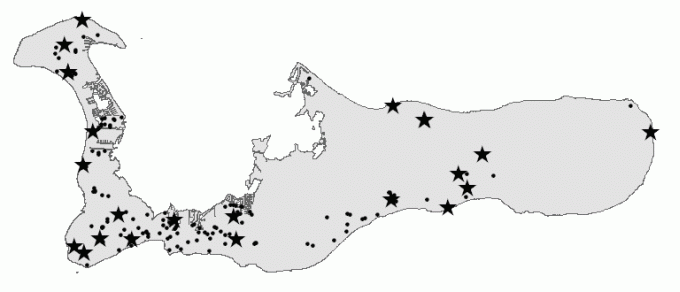
Fig. 1. The location of all potential freshwater turtle sites surveyed between March and June 2007. Locations marked with a star represent those sites where water quality sampling was carried out.
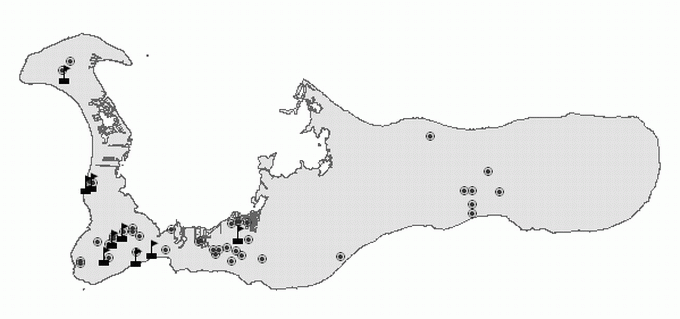
Fig. 2. The distribution of hickatees and red-eared slider turtles on Grand Cayman. Ponds with hickatees are marked with a circle and ponds with both hickatees and red-eared sliders marked with a flag.
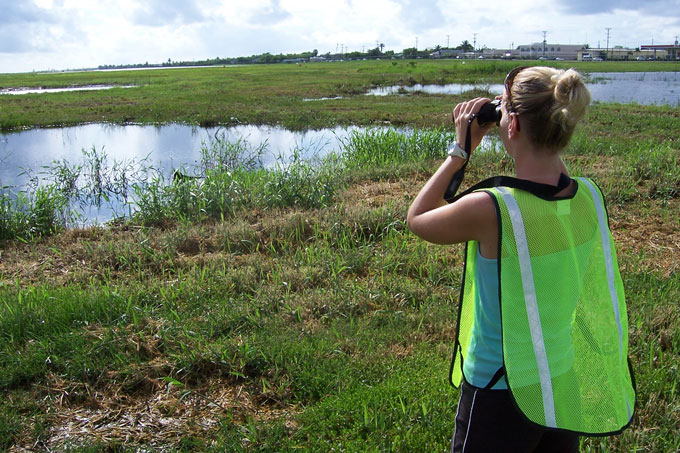
Fig. 3. Scanning ponds close to the airport.
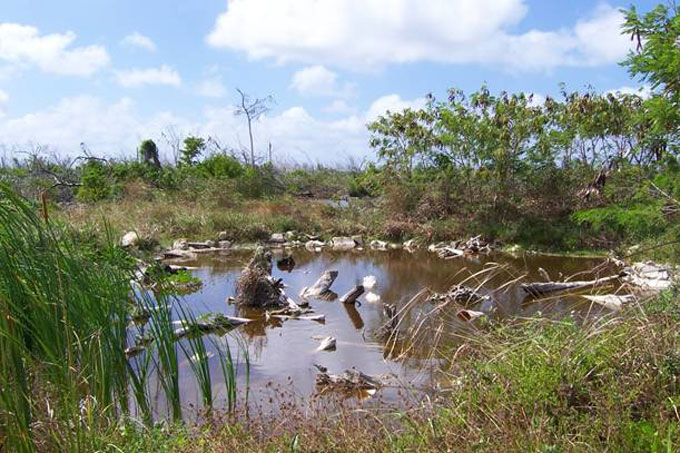
Fig. 4. Pond with denser marginal vegetation.
Turtle capture and sampling
Turtles were captured at 11 locations across the island, using a hand-held landing net and a single standard basking trap constructed from wire mesh and 10.2cm-diameter PVC piping (Williams, 2002). The basking trap was utilized at only a few ponds that had a large number (>20) of turtles present and was checked at dawn and dusk on a daily basis. Once captured, morphometric data including straight and curved carapace length (CCL) in cm were collected following Bolten (1999). Photographs were taken of the carapace, plastron and head of all captured individuals. To individually identify turtles, Cagle’s (1939) system of marking was used which consisted of a series of notches filed into the appropriate marginal scutes with a triangular file. All turtles were sexed on a combination of front claw length and tail length and position of the cloaca (Seidel, 1990). Captured turtles were also temporarily marked by applying a grease pen to their carapace to ensure that they were not recaptured within a single capture session. All turtles were processed and released within 30 minutes at their capture site.
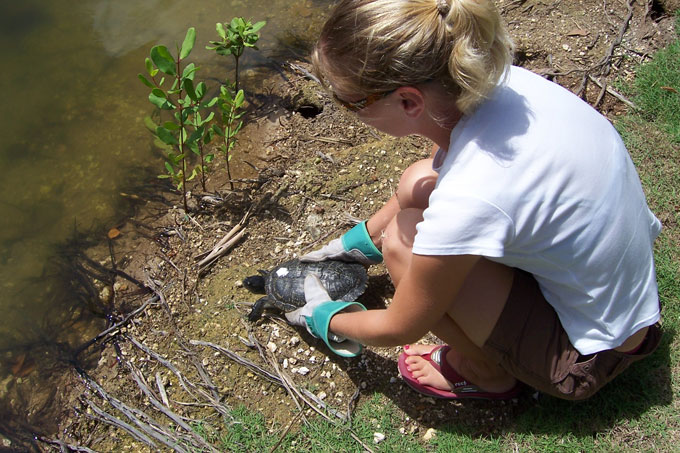
Fig. 5. Turtle being returned to the water after being notched and marked with a grease pen.
Results
Surveying
A total of 154locations were visited on Grand Cayman (Fig. 1), most of which werelocated in the west of the island. The east of the island isgenerally much drier and substantially fewer suitable water bodiescould be found, although there are large tracts of private propertywhich were not surveyed. Across the island, 44 ponds were found tocontain freshwater turtles with nine ponds having both red-earedsliders and hickatees present and the remaining 35 ponds containinghickatees only (Fig. 2). Red-eared sliders were only recorded in thewest of the island, whereas the hickatee population was morewidespread (Fig. 2).
Turtle capture and sampling
A total of 91 turtles were captured. All turtles were sexed with the exception of a single individual that was too small (less than 10cm) for accurate sex determination. The ratio of males to females was well balanced with 47 males and 43 females. Only six individuals captured were less than 16cm CCL.
Discussion
Previous work on the hickatee had stated that it was only found on the western half of Grand Cayman and a single set of ponds in central Cayman Brac (Brunt & Davies, 1994). The results of this study show that the population has since spread eastward and are now to be found in water bodies across the whole of Grand Cayman. Cayman Brac was not surveyed and it is unknown if a similar range expansion has occurred there also. The expansion in range may be due to dispersal away from populated areas in the west but is in all likelihood due to initial human displacement followed by more local dispersal. Anecdotally, it appears that it is common for turtles to be taken from the wild and placed in ponds on private property (Fig. 6). The locations of the populations studied by Seidel (1990) appear to have been altered somewhat through development but the most substantial populations still occur in the south-west region of the island. However, it should be noted that freshwater turtles of both species may exist in substantial numbers elsewhere on Grand Cayman. The surveying was not exhaustive and there are large tracts of private property, which are known to have water bodies located on them, that were not surveyed. Therefore, estimates of hickatee and red-eared slider numbers and distribution need to be taken very much as minimum estimates. Furthermore, in many areas there is dense vegetation surrounding ponds and it was not always possible to penetrate this to be able to perform detailed observations.
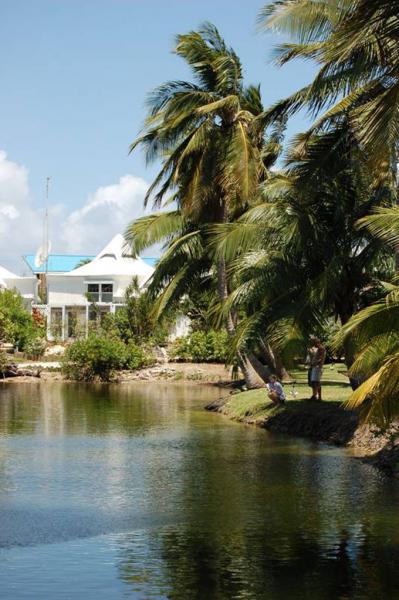
Fig. 6. Turtle habitat on private property.
Potential threats
Habitat loss, degradation and fragmentation can lead to alteration of population structures and declines in freshwater turtles. Terrestrial movement of freshwater turtles is often seen when ponds dry out – and during the mating season when males search for mates and females search for nesting sites (Steen, 2004). The presence of roads is of particular concern for turtle populations. Many ponds in Grand Cayman are located next to roads and mortality of four turtles was observed during this project. On Grand Cayman, road networks are increasingly expanding due to the high volume of traffic found on the island and, for the hickatee, mortality could have a major impact on populations. There is also an impact on turtles living in hotel complexes and on golf courses – where fences and other barriers block movements and create isolated populations. This isolation may ultimately lead to reduced genetic variability within populations (Marchand, 2004) and increased hybridisation. Freshwater systems have also been opened up to the sea by the removal of mangroves, creating saltwater systems that freshwater turtles cannot tolerate for long periods.
The Cayman Islands are also highly susceptible to hurricanes. The most devastating storm to hit Grand Cayman in recent times was Hurricane Ivan, a category five hurricane that flooded a quarter of the island in September 2004. Anecdotal evidence suggests that Ivan altered freshwater turtle populations with many turtles being displaced. There were also local reports of dramatic drops in numbers and a complete absence of turtles from well-known sites, most likely due to turtles being washed out to sea. Hurricanes are known to reduce turtle populations through flooding and predation (Ernst, 1974) and in Grand Cayman Hurricane Ivan may have depleted an age class of hickatees (Fig. 7). Maturation of hickatees is 6-10 yrs for females (150-210mm plastron length or PL) and 4-10 yrs for males (85-110mm PL) which is similar to that of red-eared sliders (Seidel, 1990). Nesting occurs from April to July with an incubation period of 90 days. This means that when Ivan took place in September, clutches from 2004 would have consisted of both eggs and hatchlings, and been easily washed away along with juvenile turtles. This might explain our pronounced lack of small individuals captured.
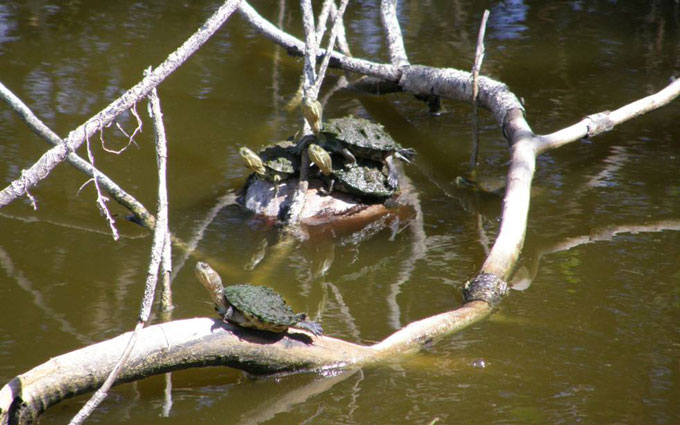
Fig. 7. Juvenile hickatees basking.
Hickatees and red-eared sliders are very closely related and are able to produce viable offspring (Cadi et al., 2004) and as such it is highly likely that hybridisation is occurring between the two species. A visual inspection of some of the turtles sampled in this study seems to suggest that they are hybrids (Fig. 3), although this would need to be confirmed through DNA testing.
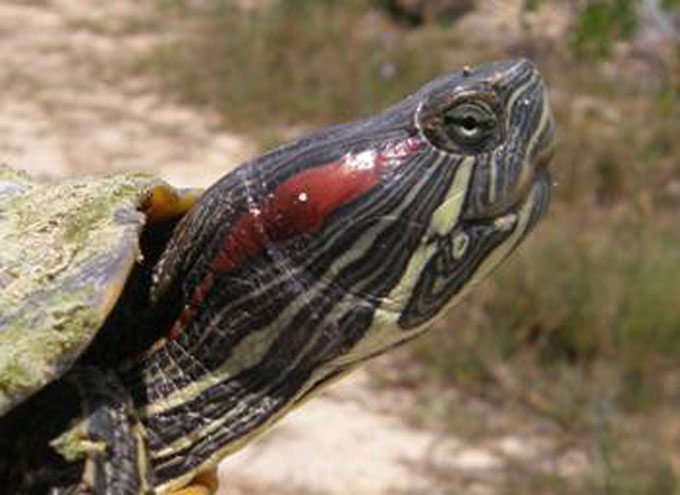
Fig. 8a. Red-eared slider.
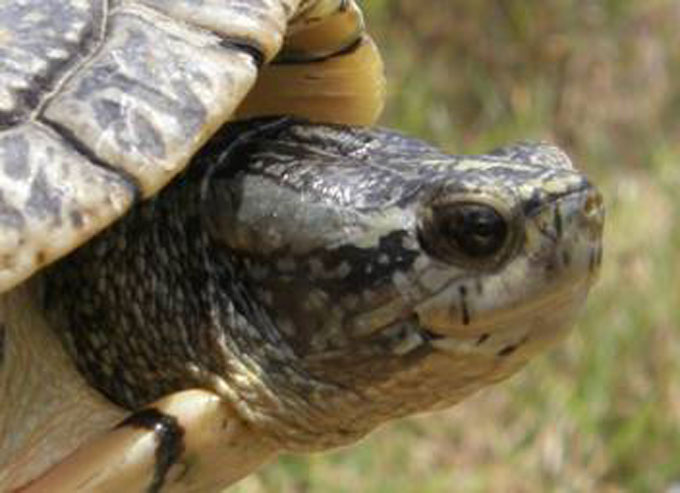
Fig. 8b. Hickatee.
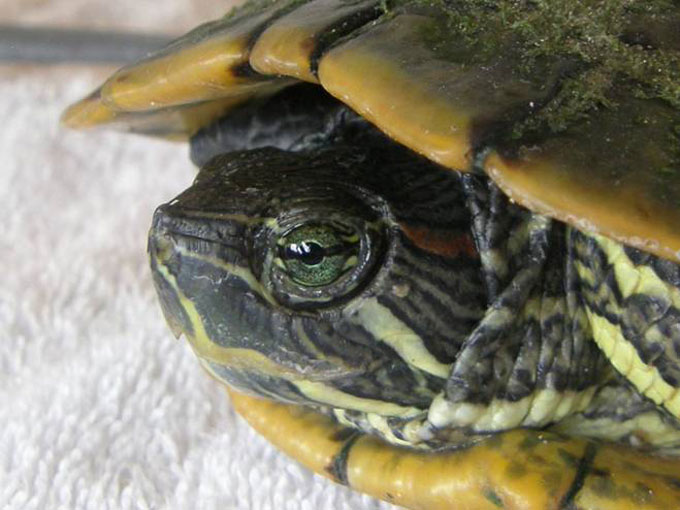
Fig. 8c. Potential hybrid.
Management of the red-eared slider
The red-eared slider is listed as one of the ‘Top 100 invasive species’ by the IUCN. Within the European Union, imports of T. s. elegans have been banned since December 1997. There are also countries where red-eared sliders have been actively targeted, trapped and removed from the wild (www.issg.org). On Grand Cayman there is an emotional attachment to the freshwater turtle and therefore control strategies will have to be sensitive to public perceptions and preferences. Educational campaigns, and the instigation of a scheme for dealing with unwanted pets, should be used to inform the public of the impact of the invasive turtle and the importance of not releasing them into water systems. If more direct action is to be taken then control of red-eared sliders could be reasonably straightforward because at present the bulk of the red-eared slider population is found at two main locations. However, complete removal would undoubtedly be very difficult and time consuming. In the British Virgin Islands a programme to remove an introduced population of red-eared sliders was undertaken and several attempts were needed to completely remove turtles from a single location (Perry et al., 2007).
Conclusion
From the evidence seen, red-eared sliders are surviving successfully and reproducing on the Cayman Islands. However, more research is needed. At present, populations of red-eared sliders are localised and not a severe threat but this could change in time.
Acknowledgements
Many thanks go to the British Chelonia Group and the Darwin Initiative whose financial support made this project possible. I am very grateful to all the staff at the Department of Environment, Grand Cayman for making us feel welcome and helping wherever needed. Thank you to Gina Ebanks-Petrie for letting the project take place, Janice Blumenthal for your guidance and support, Jeremy Olynik for your genius in GIS, James Gibb for helping whenever it was necessary and John Bothwell for giving up your days to help with sampling. Valuable information was provided by the Department of Agriculture and Fred Burton and Chris Carr from the Blue Iguana Recovery Program, for which I am grateful. Thanks to Brendan Godley, Andy McGowan and Mat Cottam for your supervisory excellence and to Nicola Simpson for being an amazing person to work and share this experience with.
References
Bolten, A.B. (1999). Techniques for measuring sea turtles. In: Research and Management Techniques for the Conservation of Sea Turtles (eds K.L. Eckert, K.A. Bjorndal, F.A. Abreu-Grobois & M. Donnelly). IUCN/SSC Marine Turtle Specialist Group Publication No. 4, pp. 110-114.
Brunt, M.A. & Davies J.E. (eds) (1994). The Cayman Islands Natural History and Biogeography. Kluwer Academic Publishers, Boston.
Cadi, A. & Joli, P. (2003). Competition for basking places between the endangered European pond turtle (Emys orbicularis galloitalica) and the introduced red-eared slider (Trachemys scripta elegans). Canadian Journal of Zoology 81: 1392-1398.
Cadi, A. & Joli, P. (2004). Impact of the introduction of the red-eared slider (Trachemys scripta elegans) on survival rates of the European pond turtle (Emys orbicularis). Biodiversity and Conservation 13: 2511-2518.
Cagle, F.R. (1939). A system of Marking Turtles for Future Identification. Copeia 3: 170-173.
Ernst, C.H. (1974). Effects of Hurricane on a Painted Turtle Population. Journal of Herpetology 8: 237-240.
Kairo, M., Ali, B., Cheesman, O., Haysom, K. & Murphy, S. (2003). Invasive Species Threats in the Caribbean Region – Report to The Nature Conservancy. 134pp.
Klemens, M. (2000). Turtle Conservation. Smithsonian Institute, USA.
Marchand, M.N. & Litvaitis, J.A. (2004). Effects of Habitat Features and Landscape Composition on the Population Structure of a Common Aquatic Turtle in a Region Undergoing Rapid Development. Conservation Biology 18: 758-767.
McMillan, M. & Wilcove, D. (1994). Gone but not forgotten: Why have species protected under the Endangered Species Act gone extinct? Endangered Species Update 11: 5-6.
McNeely, J. (2001). Invasive Species: a costly catastrophe for native biodiversity. Land Use and Water Resources Research 2: 1-10.
Mooney, H.A. & Cleland, E.E. (2001). The Evolutionary Impact of Invasive Species. PNAS 98: 70-72.
Oldfield, S. & Sheppard, C. (1997). Conservation of Biodiversity and Research Needs in the UK Dependant Territories. Journal of Applied Ecology 34: 1111-1121.
Perry, G., Owen, J.L., Petrovic, C., Lazell, J. & Egelhoff, J. (2007). The red-eared slider, Trachemys scripta elegans, in the British Virgin Islands. Applied Herpetology 4: 88-89.
Roman, C.T., Aumen, N.G., Trexler, J.C., Fennema, R.J., Loftus, W.F. & Soukup, M.A. (1994). Hurricane Andrew’s Impact on Freshwater Resources. BioScience 44: 247-255.
Schlaepfer, M.A. et al. (2005). Challenges in Evaluating the Impact of the Trade in Amphibians and Reptiles on Wild Populations. Bioscience 55: 256-264.
Steen, D.A. & Gibbs, J.P. (2004). Effects of Roads on the Structure of Freshwater Turtle Populations. Conservation Biology 18: 1143-1148.
Waide, R.B. (1991). Summary of the Response to Hurricanes in the Caribbean. Biotropica 23: 508-512.
Williams, K. (2002). Turtles and turtle traps. Aquaculture and Pond Management Quarterly Feature, Spring 2002. Langston University Agricultural Research and Extension Programs. Langston, Oklahoma (www2.luresext.edu/aquaculture/turtles.htm)
Testudo Volume Seven Number One 2009
Top










